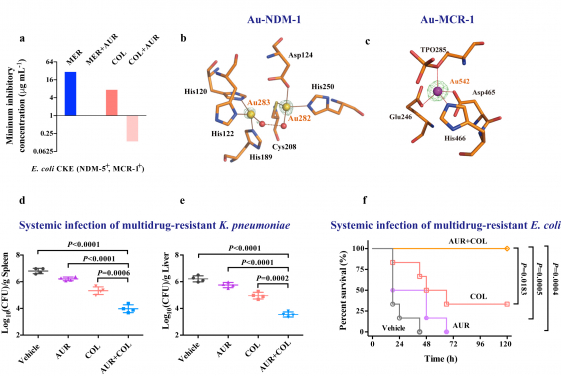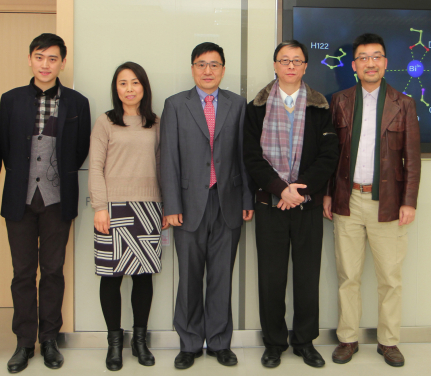Media
HKU scientists reveal an antirheumatic metallodrug can
resurrect “last-resort” antibiotics to kill multi-drug resistant superbugs
05 Nov 2020

Image 1. (a) Minimum inhibitory concentration of MER or COL against E. coli CKE (MCR-1+, NDM-5+) in the absence or presence of AUR. (b) Structure of the active site of Au-NDM-1 (PDB ID: 6LHE) with the anomalous density peak of Au shown as yellow spheres and water molecules as red spheres. (c) Structure of the active site of Au-MCR-1-S (PDB ID: 6LI6) with the anomalous density peak of Au ion shown as a purple sphere. (d,e) Balb/c mice were given a sub-lethal dose of K. pneumoniae (MCR-1+) and received single dose of administration of vehicle, AUR, COL or their combination. Bacterial loads in the spleen (d) and liver (e) are shown. c, Survival curves showing combination efficacies in the peritonitis infection model. Balb/c mice were infected by a lethal dose of E. coli CKE (MCR-1+, NDM-5+) and received single dose of administration of vehicle, AUR, COL or their combination.

Image 2. From the right: Dr Richard Yi-Tsun KAO (Associate Professor, Department of Microbiology, HKUMed), Dr Pak-Leung HO (Director of the HKU Carol Yu Centre for Infection from the Department of Microbiology), Professor Hongzhe SUN (Norman & Cecilia Yip Professor in Bioinorganic Chemistry and Chair Professor of Research Division for Chemistry), Dr Hongyan Li (Senior research associate, Research Division for Chemistry) and Dr Runming Wang (Postdoctoral researcher, Research Division for Chemistry).
A research team led by Professor Hongzhe SUN, Chair Professor from the Research Division for Chemistry, Faculty of Science, in collaboration with Dr Pak-Leung HO, Director of the HKU Carol Yu Centre for Infection from the Department of Microbiology, Li Ka Shing Faculty of Medicine, The University of Hong Kong (HKU) discovers that by repurposing an antirheumatic gold drug, auranofin (AUR), "last-resort" antibiotics can be resensitized for treatment of infections caused by multidrug-resistant superbugs including bloodstream infections, pneumonia and wound infections.
The findings provide insights into development of inorganic pharmaceutics and new therapeutic approach for superbug infections. The ground-breaking findings on antimicrobial resistance (AMR) are now published in a leading multidisciplinary science journal, Nature Communications and a related patent has been filed in the US.
Background
Antibiotics are medicines designed to kill bacteria and treat bacterial infections. Antibiotic resistance occurs when bacteria adjust in response to the misuse or overuse of these medicines and it has become one of the biggest public health challenges in this era. At least 2.8 million people get an antibiotic-resistant infection annually in the US, and more than 35,000 people die from it.
The most commonly used antibiotics to treat bacterial infections are β-lactams antibiotics, such as cephalosporins and carbapenems. However, their clinical efficacies have been greatly challenged as bacteria produce a resistant determinant that are capable of hydrolysing nearly all β-lactams antibiotics, named metallo-β-lactamases (MBLs). Therefore, the "last-line" antibiotic colistin (COL) has re-emerged as a therapeutic option in response to the outbreak of infections caused by extensively multidrug-resistant Gram-negative pathogens since the mid-1990s. Unfortunately, the efficacy of COL has also been seriously compromised in the regular treatment of lethal bacterial infections, owing to the emergence of another resistant determinant, mobilized colistin resistance (MCR) enzyme in 2015.
Owing to the vast structural difference and mode of mechanisms between the two enzymes, it remains an extreme difficulty of adopting a general therapy for infections caused by MBL(s) and MCR(s) co-producing pathogens. As said by Dr Tedros ADHANOM GHEBREYESUS, Director-Genera of World Health Organization (WHO), "As we gather more evidence, we see more clearly and more worryingly how fast we are losing critically important antimicrobial medicines all over the world." Thus, in clinic context, common infections with these "superbugs" may soon be untreatable, which will severely endanger public health system and leave clinicians with virtually no therapeutic options.
Key findings
With little remission from the therapeutic reliance on the current pipeline of β-lactam antibiotics and COL, the combination therapy consisting of an antibiotic resistance and an antibiotic-resistance breaker offers promising options to narrow the gap between multidrug-resistant bacteria and the development of new antibiotics. The research team previously discovered an anti-peptic ulcer bismuth drug, colloidal bismuth subcitrate, potently inhibits MBL activity and re-sensitize MBL-positive bacteria to β-lactam antibiotics. The related works were published in Nature Communication in 2018 and it was ranked as Highly cited paper in this area.
Their new findings follow this widely-recognized discovery, and identifies AUR serves to revive the potency of both carbapenem such as meropenem (MER), and COL through a series of screening on an Escherichia coli (denoted as E. coli CKE), clinically collected by Dr Ho Pak Leung in Queen Mary Hospital in Hong Kong, that co-produces two key resistant determinants, MBLs and MCRs. They found that AUR could entirely inhibit the hydrolytic activity of MBL through targeting crucial cysteine residue in the enzyme active site and functionally disrupt MCR-1 by targeting phosphorylated Thr285 residue via a distinct metal displacement route. Significantly, the novel combinatorial therapy allows the dose of either MER or COL to be lowered by 32~64 folds to achieve the same level of effectiveness against superbug E. coli CKE, and the development of level of resistant determinant to be significantly slowed down, which will dramatically extend the life cycle of currently used antibiotics.
In the mouse model, combination therapy comprising AUR and COL is highly effective in eradicating multidrug-resistant bacteria in peritonitis infection model. Co-administration with AUR restored the in vivo efficacy of COL, with over 10-fold reduction in MCR-1-producing Klebsiella pneumoniae loads in mouse liver and spleen in comparison to antibiotic alone. More significantly, all the mice that were systemically infected by superbug E. coli CKE were saved after 5-day treatment of AUR-COL combination.
"Considering the well-recorded safety of in human, AUR as well as related gold drugs as a dual-inhibitor of MBLs and MCRs would largely broaden the therapeutic options in treating the infections caused by multidrug-resistant superbugs," said Professor Sun.
About the research team
The research was conducted by a team led by Professor Hongzhe SUN, Chair Professor of Research Division for Chemistry. Professor and his Post-doctoral fellow Dr Runming WANG are co-corresponding authors, and they are also co-first authors with Dr Zhang QI. Other HKU scientists contributing to the research the included Dr Haibo WANG, Postdoctoral fellow (Research Division for Chemistry), Miss Yuen-Ting WONG, PhD student (Research Division for Chemistry), Dr Minji WANG, Postdoctoral fellow (Research Divisoin for Molecular & Cell Biology), Professor Quan HAO, Professor (Biomedical Sciences, HKUMed), Dr Aixin YAN, Associate Professor (Research Divisoin for Molecular & Cell Biology), Dr Richard Yi-Tsun KAO, Associate Professor (Microbiology, HKUMed), and Dr Pak-Leung HO, Director of the HKU Carol Yu Centre for Infection (Department of Microbiology, HKUMed), and Hongyan Li, Senior Research Assistant (Research Division for Chemistry).
The work was supported by Research Grants Council of Hong Kong, Health and Medical Research Fund and Seed Fund for Basic Research.
About Professor Hongzhe SUN
Professor Hongzhe SUN is a Norman & Cecilia Yip Professor in Bioinorganic Chemistry and Chair Professor of Research Division for Chemistry at The University of Hong Kong. His research focuses on metalloproteins, discovery of antimicrobial agents, and inorganic chemical biology. Professor Sun has published a series of well-recognized work in overcoming antimicrobial resistance against superbugs, developing anti-coronavirus agent, and understanding the functions of metalloproteins.
More information about Professor Hongzhe SUN and his research group can be found from their group's webpage: https://chemistry.hku.hk/staff/hzsun/labPage/index.html
About the research paper: https://www.nature.com/articles/s41467-020-18939-y
Images download and captions: https://www.scifac.hku.hk/press
For media enquiries, please contact Ms. Casey To, External Relations Officer of HKU Faculty of Science (tel: 39174948; email: caseyto@hku.hk / Ms. Cindy Chan, Assistant Director of Communications of HKU Faculty of Science (tel: 3917 5286; email: cindycst@hku.hk).
